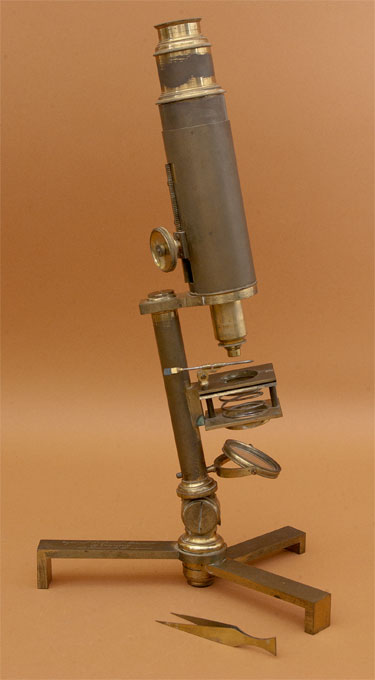This is a monocular compound microscope mounted on a cantilever arm and supported by a large, circular pillar. The microscope body is a large brass cylinder containing three lens systems: The eyepiece, field lens and objective lens. The eyepiece is the Huygenian-type with two plano-convex lenses. The field lens is biconvex and mounted a separate brass assembly. There are seven objective lenses. Each is a single biconvex optic mounted in a typical brass cup, which is screwed into a long, narrow snout. The objective snout is engraved "1" Ð "6", but the purpose of the engraving is unknown. Usually this is either the position of the Lieberkuhn or the initial focus position for each objective. However, the numbers 1Ð5 are obscured inside the microscope body so it is unclear how these numbers were used. Focus is via rack & pinion, which slides the microscope body within the brass mounting sleeve. The body is screwed into a brass cantilever, which is bolted to the top of a round brass pillar. The sample stage is screwed to the pillar, while the illuminating mirror is pinned to the pillar. The stage is an unusually deep spring stage. At the base of the support pillar is a compass joint that allows the microscope to be tilted. The entire instrument is mounted to a folding tripod base.
On one leg is engraved "Improved Compound Microscope - Crichton - 112 Leadenhall St., London". The microscope can be disassembled, folded, and packed into a mahogany storage box. There are several accessories including live-boxes, stage forceps, a dissection needle and brush, and fourteen sample slides. One interesting accessory is a free-standing candle holder. Imaging is very good, except for the predictable chromatic aberration.
John Crichton was an instrument maker who worked in London from 1831 to 1865 producing and selling barometers, magnetic compasses, drawing instruments, thermometers, sextants and telescopes, as well as microscopes, such as the one seen here. Crichton worked mainly at 112 Leadenhall St, London.
Featured 04/2014






